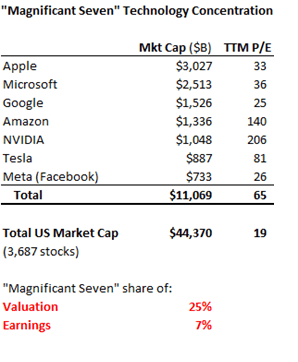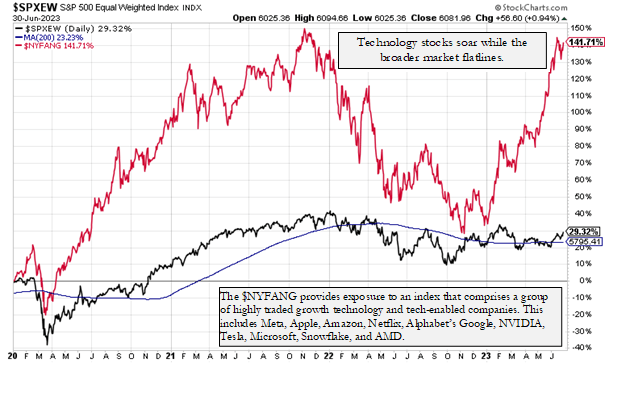Summary:
- Nvidia, Apple, Amazon, Microsoft and Google, and have largely driven the percentage gains in the US stock market this year.
- The AI ‘bell cow’ leading the new investment narrative is Nvidia.
- Nvidia’s market capitalization is 37% greater than Berkshire Hathaway.
- At its current price of $423, Nvidia is valued at forty times its annual revenue.
- While most rational investors consider Nvidia ‘slightly’ overvalued, market momentum could push fantasy valuations higher.
BING-JHEN HONG
The following segment was excerpted from this fund letter.
Artificial Intelligence – the new pixie dust
Last year’s mild stock market pullback reversed in October, as market participants such as retail investors, exchange-traded funds, institutions, and hedge funds piled back into the shares of Apple (AAPL), Microsoft (MSFT), Google (GOOG,GOOGL) , Amazon (AMZN), Nvidia (NASDAQ:NVDA), META, and Tesla (TSLA). These stocks were deemed the most liquid and considered “cheap” enough to own in size. This year, Artificial Intelligence (AI) is the new pixie dust, further enticing participants deeper into market darlings. Presently, every Wall Street analyst makes the case that these technology giants will disproportionately benefit from the AI boom. The excessive hype surrounding AI to justify forward earnings estimates and current valuations may seem absurd but is not unexpected—it follows the same pattern every cycle. Or, as Kurt Vonnegut once wrote, “History is merely a list of surprises. It can only prepare us to be surprised yet again.”
Bloomberg Data; July 3, 2023
Apple and Microsoft together possess a market value exceeding $5.5 trillion. If one includes Nvidia, with a market value of just over $1 trillion, the cumulative worth of these three companies nearly matches the entire economies of France ($2.8 trillion) and Germany ($4.1 trillion). This comparison highlights the extraordinary valuation, rivaling two of the world’s largest industrial economies. Further, this sum ignores Google ($1.5 trillion) and Amazon ($1.3 trillion). Apple, Amazon, Microsoft, Google, and Nvidia have largely driven the percentage gains in the US stock market this year. In fact, Apple and Microsoft now account for almost 15% of the market capitalization of the S&P 500 index, the largest percentage total for any two companies since 1980 (IBM and AT&T).
If the S&P 500 was weighted equally, rather than by market capitalization, its performance over the last three years looks anemic. The equal weight index provides a better understanding of the breadth of the market and the economy. Of course, not all stocks are equal, as some hold greater significance than others. Some businesses are poised to benefit and grow more due to the ongoing AI revolution. One could argue that the aforementioned five companies provide substantial exposure to AI, potentially unleashing a wave of creative destruction. However, caution is warranted when 25% of the entire U.S. stock market capitalization is concentrated in just seven technology companies, trading at materially different earnings multiple of the remaining 3,687 businesses

Nvidia – leading the new investment narrative
The AI ‘bell cow’ leading the new investment narrative is Nvidia, currently priced at a level where its free cash flow yields only 0.45% for its shareowners; by comparison, riskless U.S. Treasury Bills now yield 5.3%. Unfortunately, 70% of Nvidia’s meager cash yield of 0.45% is further eroded by stock-based compensation (SBC) for its employees and management. The company’s stock compensation plan consumes $2.8 billion of the company’s $28 billion annual revenue but shares outstanding have not decreased. Nvidia’s market capitalization is 37% greater than Berkshire Hathaway (BRK.A, BRK.B). However, when comparing fundamentals, Berkshire Hathaway generated $23 billion in free cash flow over the past four quarters while Nvidia generated only $2.6 billion (SBC adjusted). Furthermore, Berkshire Hathaway does not dilute shareholders with stock-based compensation. Despite a wide array of available investment options, market participants have overwhelmingly favored a select few dominant technology companies.
At its current price of $423, Nvidia is valued at forty times its annual revenue. If one heroically assumes that the company manages to compound revenue by 50% per year for three years, it will “only” trade at a multiple of twelve times hypothetical sales in 2026…hardly a screaming bargain. Of course, market history has an interesting way of repeating itself. The most exaggerated technology bubble occurred in 1928-29 when the Radio Corporation of America (RCA) captured the imagination of every speculator on Wall Street. RCA’s trading volume sometimes accounted for 20% of the total volume on the New York Stock Exchange. At the stock price peak in September 1929, the company was “valued” at $665 million. Sales increased from $65 million in 1927 to $102 million in 1928 to $182 million in 1929. Therefore, at the peak of the RCA stock buying frenzy, the company was “valued” at a multiple of “only” 3.6 revenue. Forty-five years later, in 1974, RCA’s annual sales were $4.6 billion, yet the stock price bottomed that year at $38, about one-third of its 1929 stock price high.
While most rational investors consider Nvidia ‘slightly’ overvalued, market momentum could push fantasy valuations higher. Comparing the 1929 period of RCA and the current situation with Nvidia in 2023, one observes a similar pattern where most stocks experience decline while a handful of large companies powered the major indices higher. In both instances, unsuspecting investors maintained the illusion that the “market” was healthy.
In 1929, the financial press reported that the “big trusts” were primarily buying “blue chips,” liquid and “safe” components of the Dow Jones Industrial Average. These institutional trusts understood that the economy stood on shaky ground, but the music played, and they had no choice but to continue dancing. A similar phenomenon is occurring today, with institutions concentrating on a select group of technology companies that offer both liquidity and size suitable to accommodate their trading strategies. As a result, the stock market indices push higher while the broader market stagnates. Notably, during both periods, the U.S. Federal Reserve Bank was raising interest rates as the economy slid into some form of contraction. The only thing more painful than learning from experience is failing to learn from experience.
Many investors hold the belief that last year’s market experience was a “worst-case scenario”. However, it is possible that 2022 is merely the beginning of a much larger process aimed at addressing the most significant bubble in history. The personality of the stock market in recent years has been characterized by a speculative fervor as extreme as previous asset bubbles. Such a manic stock market environment, which gave birth to meme stocks and over 23,000 different cryptocurrencies, does not fade away without leaving echoes. As bubbles deflate, one can expect the resurgence of speculative behavior.
In the second quarter, the rekindling of animal spirits among active traders draws in a multitude of passive investors. This includes individuals regularly purchasing index funds for their retirement accounts, which further channels more funds to the most overvalued stocks driven by speculative activities. Additionally, volatility-targeting funds like risk parity strategies are compelled to put massive amounts of money to work in the stock market due to the success of participants in pushing prices higher. By employing extreme leverage through short-dated options, systematic fund flows create powerful forms of market misdirection that have nothing to do with company fundamentals.
From a value investor’s perspective, the misbehavior of the stock market may simply be that markets have behaved irrationally for so long, with the full endorsement of U.S. Federal Reserve policy, that most are reluctant to accept rational expectations. As concerning as that may be, one can take some comfort in Warren Buffett’s assertation that one should never bet against America. The United States remains the world’s richest, most productive, and most innovative economy. America enjoys several benefits over other major economies: prominent levels of education, better demographics, the rule of law, a more flexible economic system than Europe, and a healthier and fairer economic and political system than China. If one invested $100 in the S&P 500 in 1990, it would be worth $2,000 today, four times what would have been earned elsewhere in the developed world.
However, this statistic fails to account for the enormous growth of debt and the steady fall in the dollar value, in which the S&P 500 is denominated, over the past three decades. These factors have greatly inflated valuations, raising doubts about the likelihood of similar future gains. If the S&P 500 were to repeat this performance, it would trade at 80,000 in 2052. Achieving such a milestone would necessitate further significant inflation and currency debasement. Over the last three decades, America’s growth came not from superior economic management or policy but from an explosion of public and private sector debt and government spending. This is not success, but rather an illusion of prosperity enjoyed by a shrinking percentage of the American population.
The last century has been kind to America, and perhaps the next hundred years will follow suit. However, present-day America now confronts the challenge of inflation. To generate inflation-adjusted real rates of return, interest rates must move higher. Financially, it is nearly impossible due to excessive amounts of debt in our country’s economy, making it difficult to refinance at higher interest rates. Economically, too many companies depend on low-interest rates to support their current business model. Additionally, the U.S. government’s interest expense is now $929 billion annually, soon to exceed one trillion dollars or equivalent to the country’s entire defense budget. Over the past decade, U.S. government debt grew from $15 trillion to $32.4 trillion, a level only comparable to that after WWII.
Against this incongruous backdrop it’s remarkable to consider the year-to-date performances of some of the magnificent seven technology stocks: Apple is up 50%, Amazon is up 55%, Facebook is up 138%, and Nvidia is up 190%. One cannot help but sense the distant echoes of March 2000, when the Nasdaq Composite peaked at over 5,000. After plunging by 80% over the next two years, the Nasdaq Composite took fifteen years to regain that 5,000 level. This is a typical market pattern when one grossly overpays for an asset, even a high-quality company like Apple—overpaying today pulls forward future investment returns. The net result is that first, one loses money, and then one loses time.
Editor’s Note: The summary bullets for this article were chosen by Seeking Alpha editors.
